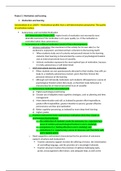Project 2. Motivation and learning
1. Motivation and learning
Vansteenkiste et al. (2009) – Motivational profiles from a self-determination perspective: The quality
of motivation matters
Autonomous and Controlled Motivation
- Self-Determination Theory (SDT): higher levels of motivation not necessarily more
desirable outcomes if the motivation is of a poor quality (i.e. if the motivation is
controlled rather than autonomous)
- Autonomous or volitional motivation consist of two subcomponents:
o Intrinsic motivation: the enactment of the activity for its own sake (i.e. for
excitement, enjoyment, and interest that is inherent to the learning itself)
When students study out of curiosity and personal interest in the learning
material, their learning is characterized by a sense of psychological freedom
and an internal perceived locus of causality
Intrinsic motivation represents the most optimal type of motivation, because
it is fully autonomous or self-determined
o Well-internalized extrinsic motivation
When students are not spontaneously attracted to their studies, they still can
study in a relatively autonomous manner, given that they foresee the
personal relevance of the learning
Although not intrinsically motivated, such students still experience a sense of
psychological freedom when they study, so that their study behaviour is
characterized by an internal perceived locus of causality
o Autonomous motivation associated with
a) Higher psychological well-being
b) Greater use of adaptive meta-cognitive strategies, such as planning and time
management
c) More determination and will, as indexed by greater effort-expenditure,
greater effort-expenditior, greater intention to persist, greater effective
perseverance and less procrastination
d) Better cognitive processing, as indexed by more deep-level learning
e) Higher grades
o Teachers and parents foster autonomous motivation when they create an
environment that facilitates:
the satisfaction of students’ needs for autonomy (i.e., experiencing a
sense of volition and psychological freedom in one’s studying),
competence (i.e., feeling effective in one’s studying), and
relatedness (i.e., experiencing a sense of closeness and friendship with
one’s student peers)
o Need-supportive environment characterized by the provision of autonomy
support, structure and involvement
Teacher autonomy support involves the offering of choice, the minimization
of controlling language, and the provision of a meaningful rationale
Teacher structure involves the provision of optimal challenging tasks,
praise, encouragement after failure, and adequate help, as well as the
, communication of clear guidelines and expectations with respect to the
task that needs to be accomplished
Teacher involvement refers to the demonstration of sincere concern and
the provision of warmth and unconditional regard
o Two subcomponents of controlled motivation
External regulation: the most pressured and controlled type of
motivation students study to avoid punishments, to obtain rewards,
or to meet external expectations. Because of its controlled nature,
external regulation is characterized by an external perceived locus of
causality
Introjected regulation: pressure themselves into action when students
have introjected reasons for studying, they have swallowed the reason
for performing the activity, so that it is now internal rather than external
(as in external regulation) behaviour comes with feelings of inner
compulsion and conflict (pressuring experience) external perceived
locus of causality
o Controlled motivation predicts a broad variety of undesirable outcomes
a) The use of maladaptive coping strategies
b) Less engagement in adaptive meta-cognitive strategies, such as
concentration and time management, and more engagement in maladaptive
strategies, such as test anxiety
c) Superficial cognitive processing
d) Less determination, as indexed by more procrastination and more dropout
e) Lower achievement
o A controlling environment can be created by pressuring students from the
outside, i.e. through the use of rewards, punishments, deadlines, or controlling
language, or by pressuring students from the inside, i.e., through the use of more
subtle and insidious tactics, such as shaming, guilt induction, or love withdrawal
Motivational Profiles and Learning Outcomes
- Number and types of motivational profiles that emerge from a person-centred analysis
may provide evidence for the internal validity of motivational frameworks
o Good quality motivation group (high autonomous, low controlled)
o Low quantity motivation group (low autonomous, low controlled)
o High quantity motivation group (high autonomous, high controlled)
o Pour quality motivation group (low autonomous, high controlled)
Findings
HIGH SCHOOL STUDENTS
- Four-cluster solution describes the variance in students’ autonomous and controlled
motivation scores
- The additional presence of controlled motivation next to autonomous motivation
detracts rather than contributes to optimal learning
- High quantity motivation group scored systematically higher on all learning outcomes
than the low quantity motivation group
COLLEGE STUDENTS




